Scottish Surveys Core Questions 2017
Official statistics publication on equality groups across a range of measures from harmonised questions in the major Scottish Government population surveys.
This document is part of a collection
3 Other characteristics
3.1 Country of Birth
The country of birth of respondents is collected in detail by the contributing surveys to the SSCQ and grouped by broad geographic location for this publication (see section 6.5). More detailed sub-groups and multi-level analysis (e.g. by ethnic group and gender) are available on request, provided there are sufficient respondents to draw statistics from.
Table 5: Age profile of country of birth groups, SSCQ 2017
| Proportion in Age Group (Row %) | Adults | Col% | ||||||
|---|---|---|---|---|---|---|---|---|
| 16-24 | 25-34 | 35-44 | 45-54 | 55-64 | 65+ | |||
| Scotland | 13 | 15 | 13 | 18 | 17 | 24 | 3,539,219 | 79% |
| Rest of UK | 13 | 15 | 15 | 17 | 16 | 24 | 503,508 | 11% |
| Rest of EU | 17 | 35 | 27 | 10 | 4 | 7 | 248,147 | 6% |
| Rest of World | 15 | 27 | 25 | 14 | 8 | 9 | 212,198 | 5% |
- In 2017, adults born in the Rest of the UK had a similar age profile to those born in Scotland, but those born in the Rest of the EU and Rest of the World were younger.
- Of those born in the UK, nearly a quarter were over 65 years, where as less than 10% of those born elsewhere were in this age category.
- Over a third of those born in the Rest of the EU were between 25 and 34 years old.
Analysis
Where formal testing is conducted, adults born in Scotland were used as the reference category for comparison.
Due to the differences in age profiles of the groups, age-standardisation was applied before comparisons are summarised below, see section 6.9. For more information about statistical tests, see section 6.10.
Country of Birth - Findings (age-standardised)
- General Health
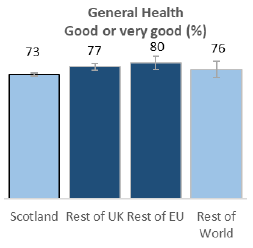
Adults born in the Rest of the UK (outside Scotland) and the Rest of the EU were more likely to report good or very good general health than those born in Scotland.
Adults born in Scotland reported a fall of 0.7 percentage points in good/very good levels of general health since 2012.
- Smoking
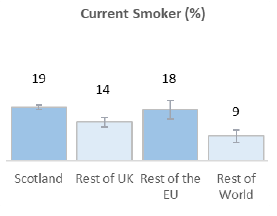
Lower proportions of adults born in the Rest of the UK (14%) and Rest of the World (9%) reported smoking in comparison to those born in Scotland (19%).
Smoking rates have fallen in all country of birth categories since 2012 and for adults born in Scotland and the Rest of the World since 2016.
- Limiting Long-Term Conditions
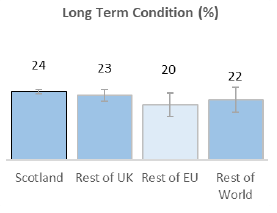
Adults born in the Rest of the EU were less likely to report having a limiting long-term health condition than those born in Scotland.
- Unpaid Care Provision
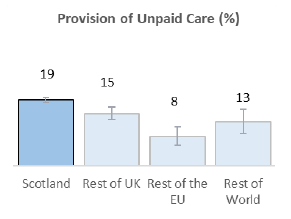
For all three groups born outside of Scotland, levels of unpaid care were lower in comparison to those born in Scotland. The lowest levels of unpaid care provision were reported by those born in the Rest of the EU (8%).
- Perception of Crime in Local Area
- Confidence in the Police
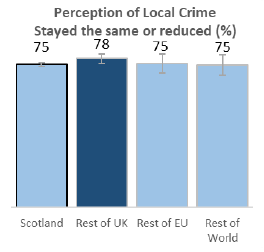
The proportion of adults who reported that crime in their local area has fallen or stayed the same in the last two years is higher for those born in the rest of the UK (78%) in comparison to those born in Scotland (75%).
Adults born in the Rest of the UK were more likely to report confidence in the ability of the police in four of the six domains (A,B,C,D) than those born in Scotland, with differences of between three and five percentage points.
Adults born in the Rest of the World reported higher confidence than those born in Scotland in the ability of the police to prevent crime (A) and respond quickly to calls and information from the public (B).
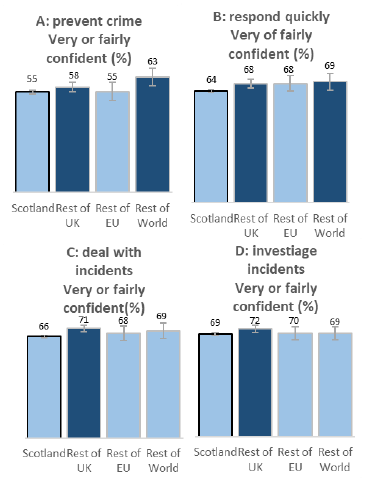
Since 2012 for adults who were born in the Rest of the World, there has been a rise in confidence in the police to catch criminals (F) by 2.7 percentage points.
3.2 Deprivation
The Scottish Index of Multiple Deprivation (SIMD) is the Scottish Government's official tool for identifying concentrations of deprivation. It incorporates several different aspects of deprivation, combining them into a single index. It divides Scotland into around 6,000 small areas, called datazones, each containing around 350 households or around 800 people.
For the purposes of this analysis, the population is split into quintiles – groups comprising 20% of SIMD areas – based on deprivation rank. SIMD does not identify all people who are deprived in Scotland because not everyone who is deprived lives in a deprived area.
Table 6: Age profile of deprivation quintile groups, SSCQ 2017
| Proportion in Age Group (Row %) | Adults | Col% | ||||||
|---|---|---|---|---|---|---|---|---|
| 16-24 | 25-34 | 35-44 | 45-54 | 55-64 | 65+ | |||
| 1 Most deprived 20% | 15 | 19 | 17 | 17 | 14 | 18 | 860,700 | 19% |
| 2 | 13 | 19 | 15 | 17 | 13 | 21 | 888,500 | 20% |
| 3 | 15 | 16 | 14 | 19 | 15 | 22 | 932,700 | 21% |
| 4 | 11 | 13 | 14 | 19 | 18 | 24 | 896,300 | 20% |
| 5 Least deprived 20% | 13 | 13 | 15 | 18 | 17 | 25 | 910,500 | 20% |
- In general there were higher proportions of younger adults in more deprived areas.
Analysis
Where formal testing is conducted, the median deprivation group (group 3) is used as the reference category for comparison.
Due to the differences in age profiles of the groups, age-standardisation is applied before comparisons are summarised below. For more information on age-standardisation, see section 6.9. For more information about statistical tests, see section 6.10.
Deprivation - Summary Findings (age-standardised)
- General Health
- Limiting Long-Term Conditions
- Smoking

- Report lower levels of good/very good general health
- Report having a limiting long-term health condition
- Smoke
The smoking rate in the most deprived group fell by 8.1 percentage points in total from 2012, the highest point reduction seen in any group.
In 2017, adults living in the most deprived areas were more likely to:
- Mental Wellbeing
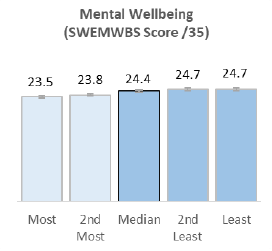
Adults living in the most deprived 40% of areas scored lower in mental wellbeing than adults living in the least deprived areas. There is a difference in average score of 1.2 between the most and least deprived 20% of areas.
- Unpaid Care
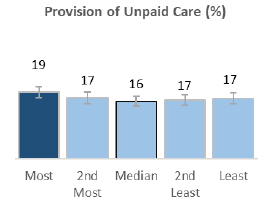
Unpaid care levels for adults living in the most deprived 20% of areas (19%) were higher than the median deprivation group (16%).
- Perception of Crime in Local Area
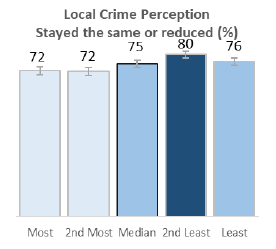
Adults in the 40% most deprived areas were less likely to report that crime in their area had reduced or stayed the same in the last two years than the median deprivation group.
These areas have seen a decrease in this indicator since 2016, with the most deprived 20% down by three percentage points and the next most deprived 20% down by five percentage points.
There was no change in these areas over the period 2012 to 2017.
- Confidence in the Police
The majority of adults report being very or fairly confident in the ability of the police, across all deprivation quintiles.
Confidence in the police was generally lower for those living in the most deprived areas, with the most deprived quintile less likely to report confidence in the ability of the police in all six domains.
Since 2012, the most deprived 20% of areas have seen an increase in confidence in the abiltiy of the police in three domains (B,E,F) of 2.4, 4.0 and 2.8 percentage points.
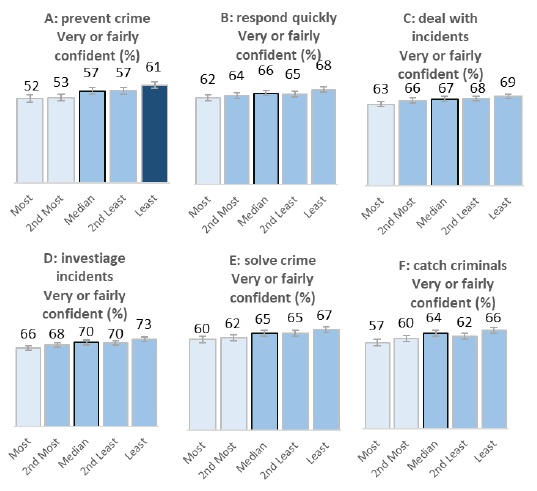
Contact
Email: sscq@gov.scot
There is a problem
Thanks for your feedback